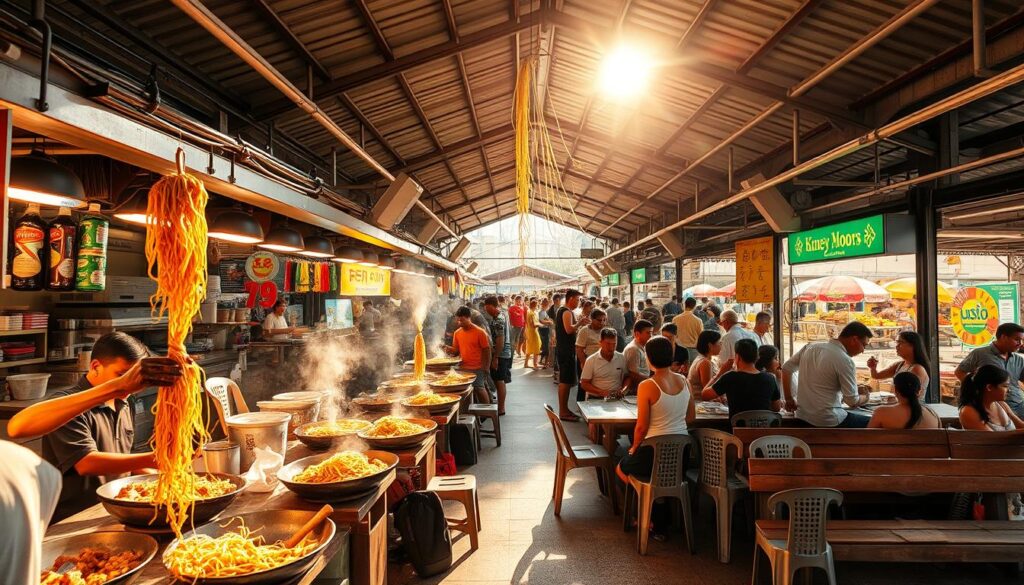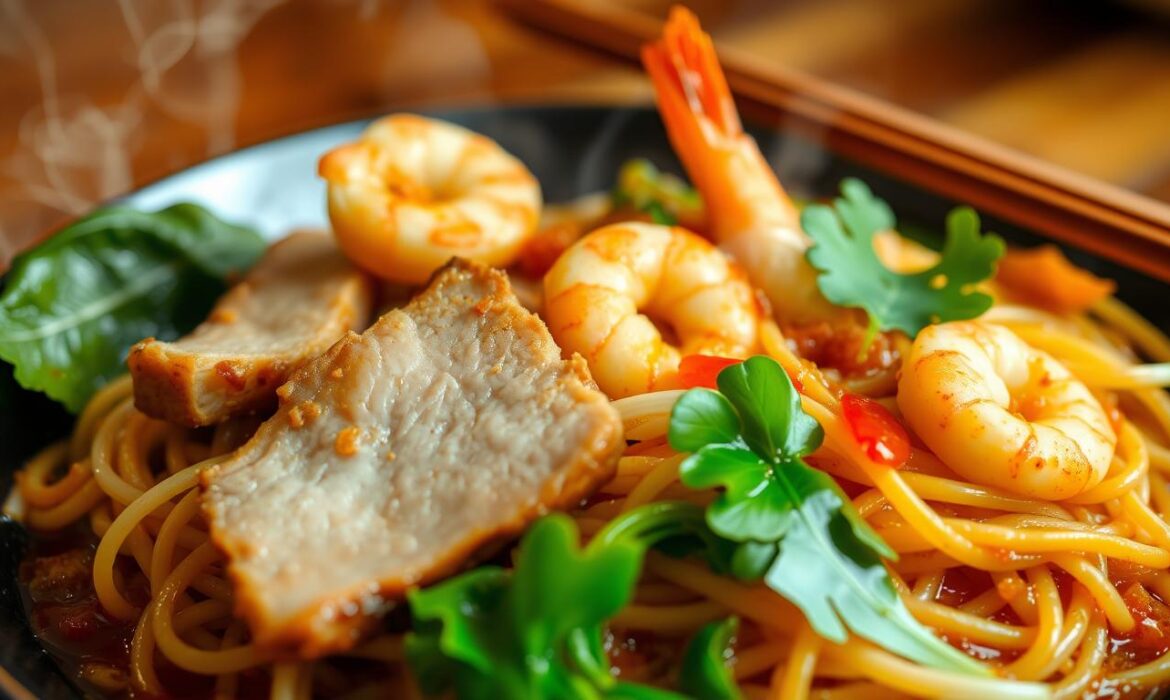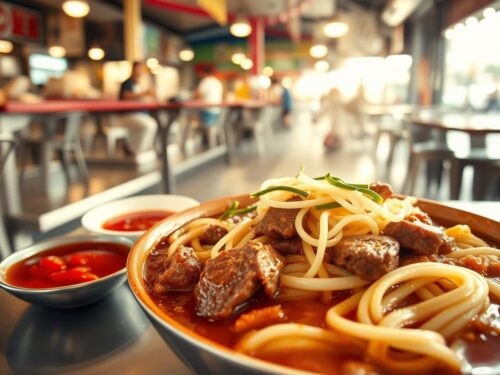Hokkien Mee is a dish that holds a special place in Singapore’s culinary heart. This flavorful noodle dish, rich in history, has evolved from a luxury item in the 1930s to a beloved hawker staple today. Its origins are debated, with some tracing it back to Hokkien immigrants and others to an ex-seaman on Rochor Road. Regardless of its beginnings, it has become a symbol of Singapore’s vibrant food culture.
This article aims to rank the top 10 stalls serving this iconic dish. From traditional recipes to modern twists, each stall offers something unique. For example, Nam Sing, a Michelin Bib Gourmand winner, is known for its exceptional quality. Portions are generous, with most dishes priced at just $5, making it a great value for money.
Whether you’re a local or a visitor, exploring these stalls is a must. The mix of traditional and innovative techniques, like French-inspired stock at Hokkien Man, ensures there’s something for everyone. Dive in and discover the flavors that make this dish a national favorite.
Key Takeaways
- Hokkien Mee is a beloved dish with deep cultural roots in Singapore.
- Its origins are debated, adding to its rich history.
- This article ranks the top 10 stalls based on quality and value.
- Stalls like Nam Sing offer exceptional dishes at affordable prices.
- Both traditional and modern cooking techniques are showcased.
Introduction to Hokkien Mee in Singapore
The story of Hokkien Mee is a fascinating journey through Singapore’s culinary history. Its origins are debated, with some tracing it back to Hokkien immigrants in the 1880s. Others believe it was created by an ex-seaman on Rochor Road in the 1930s. This dish, once known as “Rochor Mee,” evolved into a Teochew-dominated favorite after World War II.
Early adopters of this dish included Peranakan and European communities, who appreciated its rich flavors. Teochew hawkers played a key role in popularizing it, using traditional methods like charcoal fire and prawn-shell stock. These techniques gave the dish its signature smoky aroma and depth of flavor.
Historically, a plate of Hokkien Mee cost just 10 cents. Today, it remains an affordable and beloved hawker dish. Regional variations also exist, with some preferring a wet style and others a dry version. Iconic locations like Golden Mile Food Centre and Geylang Lorong 29 are known for their exceptional takes on this classic.
Whether you’re enjoying it on East Coast Road or at a bustling hawker center, Hokkien Mee continues to be a symbol of Singapore’s vibrant food culture. Its blend of history, tradition, and innovation makes it a must-try for anyone exploring the local cuisine.
What Makes the Best Hokkien Mee?
A great plate of noodles is defined by its balance of flavors and textures. For fried hokkien, this balance comes from a combination of fresh ingredients, skillful cooking techniques, and thoughtful accompaniments. Let’s break down what sets this dish apart.
First, the ingredients must be top-notch. Fresh prawns and pork are essential, as they provide the dish’s rich, savory base. The stock, often made from prawn heads and pork bones, adds depth to the flavor. Quality yellow noodles and bee hoon also play a crucial role in achieving the perfect texture.
Another key factor is wok hei, the charred aroma that comes from high-heat cooking. This technique gives the dish its signature smoky flavor. A well-prepared sambal belacan, with a balanced shrimp paste taste, adds a spicy kick that complements the dish perfectly.

There are two main styles to consider: wet and dry. The wet style is zhup-heavy, with a generous amount of broth. The dry version is stir-fried, offering a more concentrated flavor. Both styles have their fans, and the choice often comes down to personal preference.
Accompaniments like crispy lard, lime, and pickled green chili elevate the dish. These additions provide contrasting textures and flavors, making each bite unique. Here’s a quick comparison of the two styles:
| Style | Key Features | Preferred By |
|---|---|---|
| Wet | Broth-heavy, softer texture | Those who enjoy a soup-like consistency |
| Dry | Stir-fried, concentrated flavor | Fans of bold, smoky tastes |
Ultimately, the best fried hokkien is a harmony of fresh ingredients, expert techniques, and thoughtful pairings. Whether you prefer it wet or dry, this dish is a testament to the art of noodle-making.
Top 10 Best Hokkien Mee Stalls in Singapore
From smoky charcoal flavors to refined chef techniques, these stalls redefine the dish. Each spot offers a unique take on a beloved local favorite, blending tradition with innovation. Whether you’re craving a rich broth or a bold stir-fry, this list has something for everyone.

10. Nam Sing Hokkien Fried Mee
Located on Old Airport Road, Nam Sing is a heritage stall with a Michelin Bib Gourmand award. Their prawn-shell and liver-infused stock create a rich, savory base. Portions are generous, priced at $5 or $8, making it a great value.
9. Original Simon Road Fried Hokkien Mee
This third-generation family stall is known for its creamy broth and free lard toppings. The recipe has stood the test of time, offering a comforting bowl of noodles.
8. Ah Hock Fried Hokkien Noodles
A favorite at Chomp Chomp, Ah Hock specializes in the dry-style version. Their Michelin Plate recognition speaks to the quality of their thin bee hoon and flavorful prawns.
7. Xiao Di Fried Prawn Noodle
Xiao Di uses a Thai prawn-head broth for a unique twist. While quality can be erratic, their fiery house sambal adds a memorable kick.
6. Geylang Lorong 29 Charcoal Fried Hokkien Mee
Charcoal-fired since the 1950s, this stall delivers a smoky essence. Their opeh-leaf packaging for takeaways adds a nostalgic touch.
5. Kim Keat Hokkien Mee
Kim Keat offers a claypot option, infusing the dish with a garlic-heavy flavor. While priced higher at $11-$20, the premium ingredients justify the cost.
4. Hong Heng Fried Sotong Prawn Mee
Located in Tiong Bahru, Hong Heng adds fishcake to their homestyle cooking. The result is a comforting dish that feels like home.
3. Singapore Fried Hokkien Mee
Whampoa’s late-night option features dual chili types for added depth. It’s a go-to spot for those craving bold flavors after hours.
2. Come Daily Fried Hokkien Prawn Mee
Found in Toa Payoh West Market, Come Daily is known for its light gravy and tossed noodle method. Free-flow lard adds a crispy texture.
1. Hokkien Man Hokkien Mee
Run by an ex-Les Amis chef, Hokkien Man brings French stock techniques to the dish. Limited hours and $6-$10 portions make it a must-try.
| Stall | Signature Feature | Price Range |
|---|---|---|
| Nam Sing | Prawn-shell stock | $5-$8 |
| Geylang Lorong 29 | Charcoal-fired | $6-$20 |
| Come Daily | Free-flow lard | $4-$10 |
“The smoky aroma from the charcoal fire is what sets Geylang Lorong 29 apart.”
For more insights into Singapore’s famous noodle dishes, check out this detailed guide.
Where to Find the Best Hokkien Mee in Singapore
Exploring Singapore’s culinary scene leads you to iconic food centres. These hubs are home to some of the most sought-after stalls serving this beloved dish. Whether you’re near Toa Payoh, Old Airport Road, or Geylang, there’s a spot for every craving.

For late-night options, head to Ah Hock Fried Hokkien Noodles at Chomp Chomp Food Centre. Open till midnight, it’s perfect for those midnight cravings. Another great choice is Singapore Fried Hokkien Mee at Whampoa Food Centre, open till 11:30 PM.
Queues are common at popular spots like Nam Sing Hokkien Fried Mee on Old Airport Road. To save time, consider pre-ordering. Similarly, Xiao Di Fried Prawn Noodle has limited opening hours, so plan ahead.
If you’re in Toa Payoh, don’t miss Hokkien Man Hokkien Mee at Lor 19. Open from 11 AM to 3 PM, it’s a must-try. Pair your meal with a visit to nearby landmarks like Whampoa Food Centre, known for its other delicacies.
| Location | Stall | Opening Hours |
|---|---|---|
| Toa Payoh | Hokkien Man Hokkien Mee | 11 AM – 3 PM |
| Old Airport Road | Nam Sing Hokkien Fried Mee | 10 AM – 6 PM |
| Geylang | Geylang Lorong 29 Charcoal Fried Hokkien Mee | 12 PM – 9 PM |
For more insights into Singapore’s famous noodle dishes, check out this detailed guide.
Conclusion
Exploring the flavors of this iconic noodle dish reveals why it’s a national treasure. From the refined techniques at Hokkien Man to the traditional charcoal-fired essence at Geylang Lorong 29, each stall offers a unique experience. This hawker favorite is a must-try for anyone diving into Singapore’s culinary scene.
While this list highlights top picks, don’t hesitate to venture beyond. Places like Swee Guan’s bring their own charm, appealing to those with acquired tastes. The affordability and accessibility of these spots make it easy to savor every bite.
Share your personal favorites on social media and join the conversation. Whether you’re a local or a visitor, this dish is a delicious way to connect with Singapore’s vibrant food culture.



